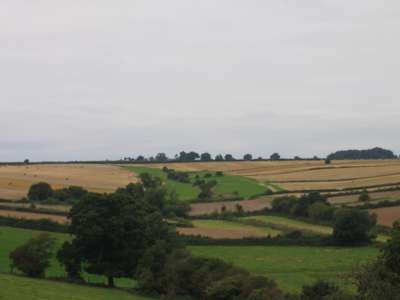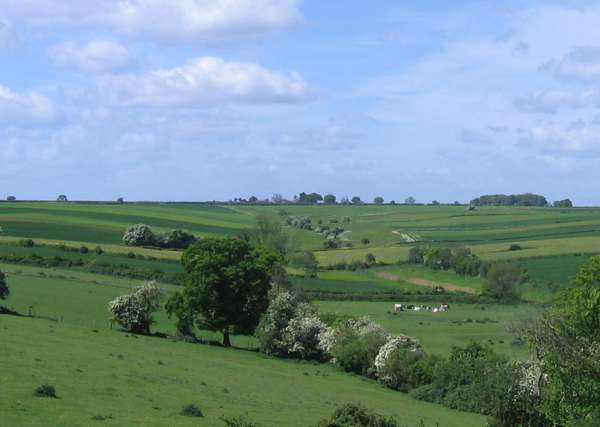 |
 |
Strips after harvest in West Field, also known
as
Top Field, clearly showing Radbeck Syke between
the two rows of
facing strips and a road used for
access by farm vehicles. |
The same view in May
as the second year crop is
starting to grow strongly. The different shades of green
in the strips on the left indicate the boundaries. |
Each of the fields is divided into strips
and each farmer has an allocation of strips in each field to share out
the good and bad land and that nearer and further from the village
centre.Even if a farmer works
adjacent strips, the furrow denoting the boundary is maintained. The
narrow gateways into the Open Fields and the small size of the strips
restrict the size of the equipment used to work them. Strips range in
size between about 1 acre and about 7 acres. The holdings of individual
farmers range between 120 - 140 acres.
Not all farmers have an equal area of
land in each field. This affects their return each year as when the
field in which they have a large holding is fallow, they harvest much
less than in a year when the field is in production. The impact is much
worse if the fallow year happens to be a high-yielding year, making the
potential loss greater, or equally if the years when the crop is poor
and the major holding is being harvested. This effect is masked to some
extent at the present time by the subsidies paid for conservation
management practices.
The holdings are small by modern
standards and most of the farmers either work part time in other work or
have employment elsewhere and use contractors for the intensive periods
of the year such as harvest.
There are areas within the open fields which are not assigned to any
tenancy and are known as sykes (pronounced 'six'). They are the areas
which historically were too steep or too wet to be cultivated. They
often contain a road, a drainage ditch or both and were used to turn the
plough round. Farmers must not
disturb the sykes when ploughing and must avoid spraying within six
metres of their strip boundaries to prevent them from being contaminated
by artificial fertilisers and chemicals. Many of the sykes are
designated 'Sites of Special Scientific Interest' (SSSIs)
Click here
for a large scale map of the Laxton sykes (800MB) Under Countryside
Stewardship rules, the sykes may be grazed by Laxton farmers. Natural
England has supported this practice by providing some sheep
proof fencing to promote wild flowers which benefit from being aftermath
grazed.
The growing sequence in the
3 field rotation
is:
Year 1: Wheat
Year 2: Spring / Winter Crops
Year 3: Fallow
|



